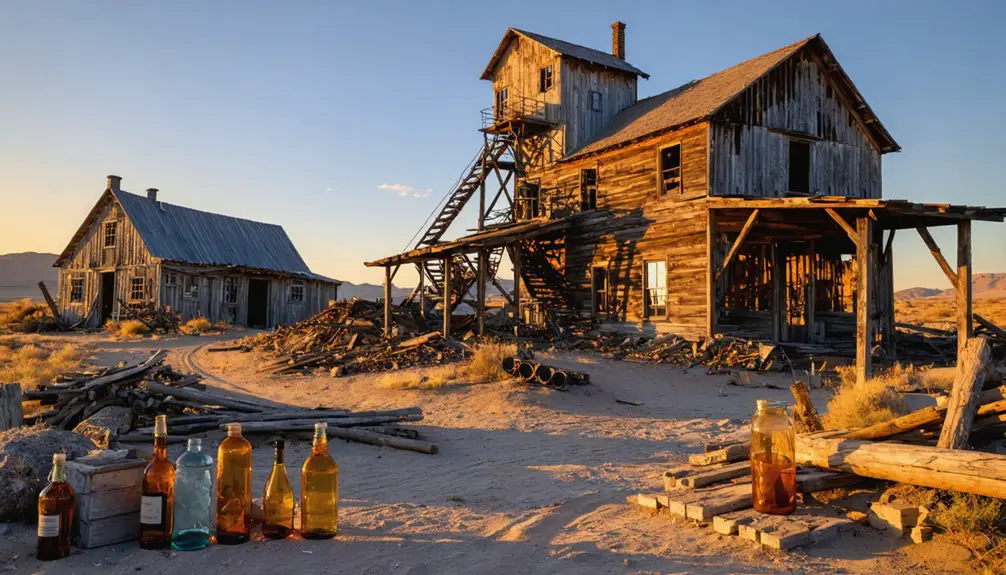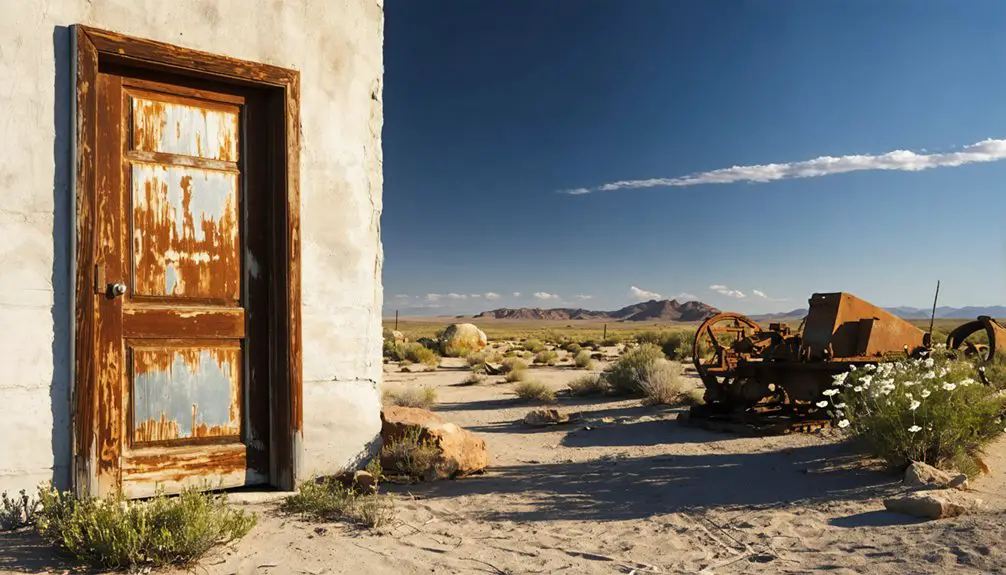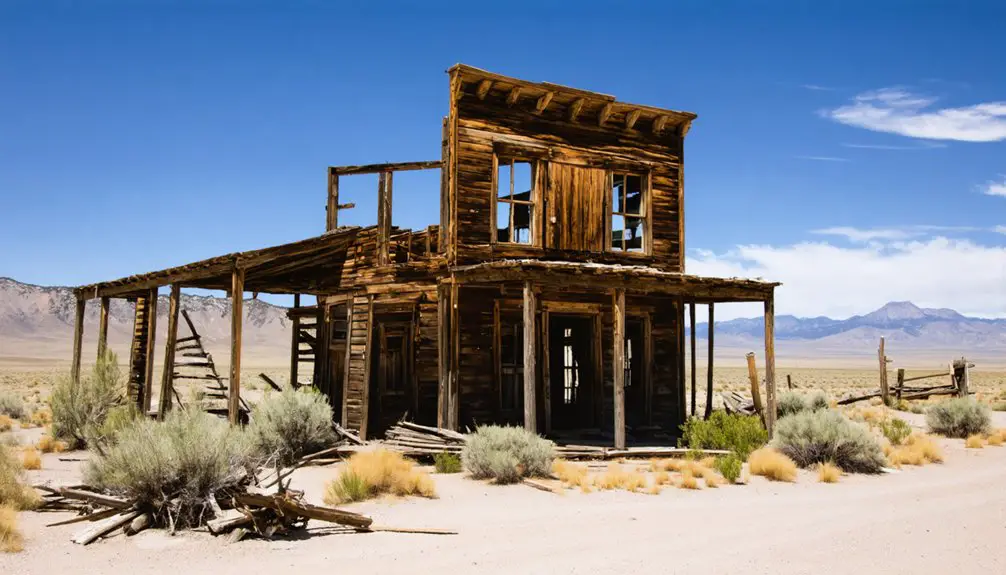You’ll find Fairview’s concrete bank vault and scattered mining remnants 40 miles east of Fallon, Nevada. Originally established as an Overland Stage stop in 1861, the site transformed after F.O. Norton’s 1905 silver discovery, growing to 2,000 residents by 1906. The Nevada Hills Mine produced $4.17 million before closing in 1917, and the post office shuttered in 1919. Today’s restricted military land holds countless stories beneath its desert surface.
Key Takeaways
- Fairview boomed after silver’s discovery in 1905, growing to 2,000 residents with 27 saloons, hotels, banks, and newspapers by 1906.
- The Nevada Hills Mine produced $4.17 million in silver before depleting ore supplies led to its closure in 1917.
- The town’s decline accelerated after 1918, with the school and post office closing, leaving only two residents by 1954.
- Military acquisition of the land for bombing practice destroyed most wooden structures by the 1980s.
- Today’s main remnant is the concrete bank vault, with scattered foundations requiring special permission for exploration.
The Origins of a Desert Stage Stop
While stagecoach lines crisscrossed the American West in the 1860s, Fairview’s stage stop emerged as a significant waypoint on the Overland Stage Trail in 1861.
You’ll find this stop predated the town of Fairview by 45 years, serving as an important relay point where stagecoach routes connected Fallon to bustling mining camps like Wonder. Passengers endured rough meals consisting of beans and hardtack, reflecting the limited food preservation methods of the era.
Desert logistics proved challenging at this Churchill County location. Natural springs created small oases, but water scarcity remained a constant threat – much like at nearby Frenchman Station, where water had to be hauled twelve miles.
Despite these harsh conditions, the stage stop fulfilled its essential role in the region’s transportation network until 1869, when the transcontinental railroad’s completion marked the beginning of the end for many stagecoach operations. The area later became a thriving community when rich silver ore was discovered in 1905.
Silver Strike and Town Formation
After prospector F.O. Norton made his silver discovery on Fairview Peak in 1905, you’d have witnessed one of Nevada’s most explosive mining booms.
When P. Langsden located the Nevada Hills Mine in January 1906, prominent mining investors George Wingfield and George Nixon quickly seized the opportunity, purchasing multiple claims that March.
By June 1906, you could’ve found yourself among 2,000 residents in the newly platted townsite, where freedom-seeking prospectors paid premium prices:
- Land at $100 per front foot
- Water at $2.50 per barrel
- Ice at $4 per 100 pounds
The boom town’s rapid growth brought 27 saloons, two hotels, banks, and two competing newspapers. Wood cost $20 per cord to heat the growing number of establishments.
Daily stages connected you to Wonder and Fallon, though the promised railroad never materialized. They transported valuable ore to Hazen for shipment to smelters.
Life in the Boomtown Years
During Fairview’s peak years of 1906-1907, you’d have found a bustling community of nearly 2,000 residents enjoying the amenities of a proper Nevada boomtown.
Much like Fair View School in Arkansas, the town maintained educational facilities for local children.
The 27 saloons served as essential venues for community gatherings, while two competing newspapers kept you informed of local affairs and mining developments.
Your daily struggles would’ve included paying premium prices for basic necessities – $2.50 for a barrel of water, $4 for 100 pounds of ice, and $20 for a cord of wood.
Yet you’d have access to modern conveniences like banks, hotels, and a post office. The miners’ union hall provided a space for organizing and socializing, while daily stagecoach service connected you to Wonder and Fallon.
Despite the harsh conditions, the town’s infrastructure supported a thriving silver mining operation worth millions.
The Three Locations of Fairview
You’ll find Fairview’s physical development marked by three distinct locations, beginning with the 1861 Overland Mail Station that preceded the actual town by decades.
When silver was discovered in 1905, the first proper townsite emerged in a narrow canyon, but its confined space couldn’t sustain the growing population of 2,000 residents.
The town soon established itself as a bustling mining community with 27 saloons and numerous other businesses serving the local population.
Moving For Mining Access
Like many mining boom towns of the early 1900s, Fairview’s physical location shifted multiple times to accommodate the changing needs of its mining operations.
You’ll find that mining logistics drove these changes, as the town expanded from its original 1906 valley location to optimize ore extraction and processing. The area’s rich deposits of lead and silver helped drive these strategic moves.
- The initial site supported 2,000 residents but proved too distant from the mines.
- By 1907, Nevada Hills (Upper Fairview) emerged closer to the mining claims.
- A 20-stamp mill construction in 1911 cemented the town’s industrial focus.
The moves reflected practical needs – you couldn’t sustain profitable mining operations without being near the ore sources. The Nevada Hills mine was particularly productive, processing 200 tons daily of valuable ore.
Despite these strategic relocations, Fairview’s growth remained constrained by transportation challenges, particularly the lack of railroad access to efficiently move ore and supplies.
New Growth Spurs Relocation
As Fairview’s population exploded following the 1905 silver discovery by F.O. Norton, you’d have witnessed the town undergo three strategic relocations driven by urban planning needs.
The initial site, while spacious near Fairview Peak, proved inconvenient for miners traveling to work sites. Community development soon pushed the town into its second location within a narrow canyon, positioning residents closer to active mining operations.
Limited by the canyon’s width, the growing town could only expand lengthwise. When this constraint became untenable, you’d have seen Fairview make its final move to the mill area. The imposing bank vault still stands today as the last remaining structure from the first town site.
This third location offered the breathing room needed for proper town layout and improved living conditions. Major investors like George Nixon and George Wingfield fueled this rapid growth, though their planned railway connection never materialized.
Mining Operations and Economic Peak

Three key developments marked Fairview’s mining operations and economic peak: F.O. Norton’s 1905 silver discovery, George Wingfield and George Nixon’s strategic claim purchases in 1906, and the Nevada Hills Mining Company’s construction of a 20-stamp mill in 1911.
The Nevada Hills Mine emerged as a major producer in the district. These mining techniques transformed Fairview’s economic impact, generating $4.17 million in total production.
The boomtown’s prosperity attracted nearly 2,000 residents by 1907, creating a thriving community with:
- 27 saloons, hotels, banks, and essential businesses
- Two competing newspapers documenting the town’s rapid growth
- Daily stagecoach service connecting to Wonder and Fallon
Despite high commodity costs due to transportation challenges, Fairview’s mining operations sustained profitability, with Nevada Hills Mine paying reliable dividends through 1917.
The Decline and Abandonment
Despite Fairview’s initial success, the town’s decline began sharply after 1908 when external interest in mining camps waned and outside investment diminished. The economic downturn intensified by 1912, culminating in the Nevada Hills Mill’s closure in 1917 due to depleting ore supplies. Total mineral production reached $4.17 million before large-scale mining operations ceased.
The community impact was severe. From a peak population of 2,000 residents during 1906-1907, the town rapidly emptied.
You’ll find the pattern of institutional closures telling – the school shut down in 1918, followed by the post office in 1919. By 1954, only Ed and Sylvia Stratton remained.
The military’s later acquisition of the area for bombing practice sealed Fairview’s fate, with most wooden structures destroyed by the 1980s. Today, only the concrete bank vault stands as evidence of the town’s existence.
What Remains Today

Today’s visitors to Fairview will find the concrete bank vault standing as the most prominent remnant of this once-bustling Nevada mining town.
While most remaining structures have vanished, you’ll discover scattered rock foundations and mining remnants throughout the area, particularly near the Nevada Hills mine site that once processed 200 tons of ore daily.
Despite Fairview’s decline, the Nevada Hills mine area remains dotted with stone ruins recalling its 200-ton daily ore processing heyday.
The site’s exploration is limited due to its location on restricted military land, but you can still observe:
- The bank vault visible from the Austin-Lincoln Highway
- Rock foundations from old cabins, including the 1950s Stratton family residence
- Mill ruins at the New/Upper Fairview site
Most exploration requires special permission or guided tours with off-road vehicles due to the challenging terrain and military restrictions.
Frequently Asked Questions
What Was the Average Silver Grade of Ore Mined at Fairview?
You’ll find that silver mining records show ore quality averaged between 5 to 30 parts per million (0.15 to 0.87 ounces per ton), though some zones yielded exceptionally rich grades.
Were There Any Major Crimes or Notorious Incidents During Fairview’s Peak?
You won’t find documented crime statistics or notorious figures from Fairview’s peak years. Despite having 27 saloons and 2,000 residents, historical records show no major criminal events during 1906-1912.
What Happened to the Residents After Fairview Was Abandoned?
Like tumbleweeds in the wind, you’ll find most residents scattered to nearby boomtowns – mainly Tonopah and Goldfield around 1908. Ed and Sylvia Stratton stayed until 1954, when ghost town tourism began.
Did Any Famous Historical Figures Ever Visit or Stay in Fairview?
While mining magnates George Wingfield and George Nixon invested there, you won’t find records of famous visitors staying in Fairview. Despite its historical significance, no notable figures documented visits to this stage station.
Were There Any Significant Native American Settlements Near Fairview Before Mining?
Where there’s smoke, there’s fire – archaeological evidence shows Native American cultural heritage near Fairview through seasonal camps, hunting grounds, and gathering sites. You’ll find Western Shoshone and Northern Paiute used these lands extensively.
References
- https://en.wikipedia.org/wiki/Fairview
- https://www.destination4x4.com/fairview-churchill-county-nevada-ghost-town/
- https://nvtami.com/2021/02/16/fairview-nevada-1861-overland-mail-station/
- https://twainsgeography.com/location/fairview-station
- https://www.nvexpeditions.com/churchill/fairview.php
- https://www.rainesmarket.com/stations-for-stage-and-freight.html
- https://www.nevadaappeal.com/news/2020/dec/02/the-nevada-traveler-the-story-of-nearly-forgotten-/
- https://www.destination4x4.com/tag/stage-stop/
- https://shpo.nv.gov/nevadas-historical-markers/historical-markers/fairview
- https://www.nevadaappeal.com/news/2001/dec/19/the-backyard-traveler-old-mining-town-of-fairview-/



